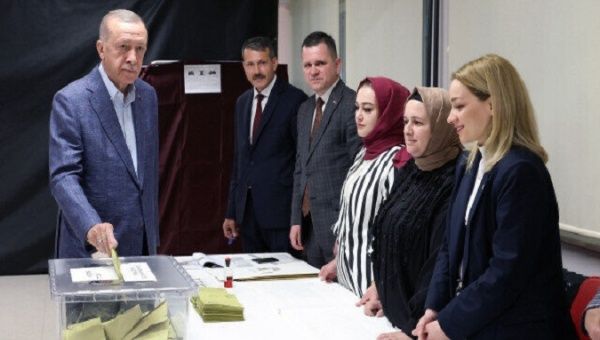DM Monitoring
ANKARA: Initial results showed Turkish President Erdogan was leading as voting concluded in Türkiye’s elections with more than 64 million eligible voters expected to have cast their ballots to elect a president and parliament for a five-year term.
The polls opened at 8:00 AM (05:00 GMT) and closed at 5:00 PM (14:00 GMT). Media organisations were barred from reporting partial results until an embargo was lifted at 6:30 PM (15300 GMT) by The Supreme Election Council (YSK).
A total of 191,885 ballot boxes have been set up for voters in the country. There are five multiparty blocs in the run-ning: the People’s Alliance, Nation Alliance, Ata Alliance, Labour and Freedom Alliance, and Union of Socialist Alliance.
The governing AK Party’s spokesperson Omer Celik said the vote-counting process was proceeding transparently.
“Our greatest wealth is having a functioning democracy,” said Celik, who claimed the spokesman for the opposition alliance and some mayors “tried to distort the data” provided by Anadolu Agency before the results were finalised.
“We respect the legal mechanisms, the counting process and the authority of the Supreme Election Council (YSK), which will announce the results.”
In July 2018, a month after Erdogan won the presidency, Turkey transitioned from a parliamentary to a presidential system, abolishing the post of prime minister. Presidential and parliamentary elections are held on the same day every five years.
There are three presidential candidates: Recep Tayyip Erdogan (AK Party), Kemal Kilicdaroglu (CHP), and Sinan Ogan (ATA).
Any candidate who can secure more than half the presidential vote on May 14 will be the winner. If no candidate can secure that, there will be a second runoff between the two top contenders two weeks later.
In a law passed by the parliament in April 2022, the election threshold decreased from 10 percent to seven percent.
More importantly, the amendments changed the way seats are distributed among member parties of an alliance.
In the past, parliamentary seats were allocated according to the total votes mustered by an alliance through common candidate lists prepared by allied political parties.
With the changes, the seats will be allocated according to the votes that each party receives individually.




